Book contents
- The Cambridge Handbook of Evolutionary Perspectives on Sexual Psychology
- The Cambridge Handbook of Evolutionary Perspectives on Sexual Psychology
- Copyright page
- Contents
- Contributors
- Preface
- Part I Precopulatory Adaptations
- Part II Copulatory Adaptations
- 8 Sexual Fantasies
- 9 Copulatory Thrusting
- 10 Female Provision of Oral Sex
- 11 The Adaptive Value of Women’s Orgasm
- 12 Copulatory Urgency: An Evolutionary Perspective of Women’s Sexual Desire
- Part III Postcopulatory Adaptations
- Index
- References
9 - Copulatory Thrusting
from Part II - Copulatory Adaptations
Published online by Cambridge University Press: 30 June 2022
- The Cambridge Handbook of Evolutionary Perspectives on Sexual Psychology
- The Cambridge Handbook of Evolutionary Perspectives on Sexual Psychology
- Copyright page
- Contents
- Contributors
- Preface
- Part I Precopulatory Adaptations
- Part II Copulatory Adaptations
- 8 Sexual Fantasies
- 9 Copulatory Thrusting
- 10 Female Provision of Oral Sex
- 11 The Adaptive Value of Women’s Orgasm
- 12 Copulatory Urgency: An Evolutionary Perspective of Women’s Sexual Desire
- Part III Postcopulatory Adaptations
- Index
- References
Summary
The role of the female in copulation as long been studied exclusively as a response to male behavior, if not completely disregarded. Nevertheless, from the establishment of physical contact until penis withdrawal, mammalian females implement a number of hormonal, physiological, and behavioral adaptations to maximize and optimize sperm capture. The initiation of copulation is mostly dependent on female receptivity and the display of behavioral estrus, including the lordotic posture. During this period, the series of copulatory acts emitted by the female is based on a sequence of inhibitory-excitatory events at the initiative of both members of the copulating pair. The significance of female interference with copulatory thrusting has been highlighted in naturalistic conditions that give the female the possibility to pace sexual interaction. In such settings, male intromission, thrusting, and eventually ejaculation are rendered physically possible by female posture, as well as optimized by somatosensory feedback from the female vulva to the penis. Genital interaction during intromission, including female pelvic, perineal, and vaginal contractions, stimulate ejaculation and may increase insemination probability by improving sperm transfer through the cervix. In addition, females can provide direct copulatory stimulation during thrusting through visual and olfactory cues, or vocalizations. The neuroendocrinological mechanisms responsible for mammal sexual adaptations are similar across species, and some basic behaviors such a lordosis present a certain interspecific rigidity. However, many qualitative aspects vary between species, notably the structure of the pattern sequence in a copulatory series, or the characteristic of sensory stimuli and their relative importance for enhancing sperm capture. In particular, human adaptations to copulatory thrusting show a wide diversity that evolutionary tools do not entirely comprehend.
- Type
- Chapter
- Information
- Publisher: Cambridge University PressPrint publication year: 2022



